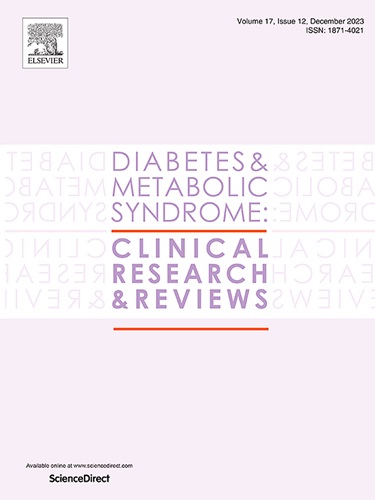非药物性糖尿病预防计划实施模式的有效性:系统综述和成分网络荟萃分析
IF 4.3
Q1 ENDOCRINOLOGY & METABOLISM
Diabetes & Metabolic Syndrome-Clinical Research & Reviews
Pub Date : 2024-10-01
DOI:10.1016/j.dsx.2024.103136
引用次数: 0
摘要
背景和目的2型糖尿病预防计划效果显著,但成本高昂且强度大,因此将其转化为常规初级保健和社区环境具有挑战性。确定干预效果的驱动因素可以为今后的务实实施提供依据,同时保持有效性。转化研究表明,实施方式会影响其有效性。本系统综述和成分网络荟萃分析评估了非药物糖尿病预防计划的哪些实施方式与降低 2 型糖尿病(或糖尿病前期)高风险人群的 2 型糖尿病发病率有关。方法我们检索了 MEDLINE、The Cochrane Library、Opengrey 和 clinicaltrials.gov 中从开始到 2022 年 11 月 17 日至少随访 12 个月的比较生活方式干预的转化研究。两名研究人员提取了数据。结果我们发现了50项符合条件的研究,涉及29286名参与者,其中包括36项(72.0%)随机对照试验、10项(20.0%)分组随机对照试验和4项(8.0%)观察性研究。成分网络荟萃分析发现,面对面(单独)给药与 2 型糖尿病发病率的更大降低相关(危险比:0.66,95 % 可信区间:0.41, 0.96),面对面(集体)给药与体重的更大降低相关(平均差异:-1.结论这项分析表明,面对面服务模式对预防糖尿病最有效。未来的研究应侧重于提高数字化项目的有效性,并确保为目标人群优先提供服务,以减少健康不平等现象。本文章由计算机程序翻译,如有差异,请以英文原文为准。
The effectiveness of delivery modalities of non-pharmacological diabetes prevention programs: A systematic review and component network meta-analysis
Background and aims
Type 2 diabetes prevention programs are effective but costly and intensive, making translation into routine primary care and community settings challenging. Identifying drivers of intervention effectiveness can inform pragmatic future implementation whilst maintaining effectiveness. Translational studies have demonstrated that delivery modalities impact their effectiveness. This systematic review and component network meta-analysis assessed which delivery modality components of non-pharmacological diabetes prevention programs are associated with reductions in type 2 diabetes incidence for individuals at high risk of type 2 diabetes (or pre-diabetes).
Methods
We searched MEDLINE, The Cochrane Library, Opengrey and clinicaltrials.gov from inception to November 17, 2022 for translational studies comparing lifestyle interventions with a minimum 12-month follow-up. Two investigators extracted the data. Random effects network meta-analyses and component network meta-analyses estimated the intervention effects.
Results
We identified 50 eligible studies involving 29,286 participants including thirty-six (72.0 %) randomized controlled trials, 10 (20.0 %) cluster randomized controlled trials, and four (8.0 %) observational studies. Component network meta-analyses found in-person (individually) delivery was associated with greater reduction in incidence of type 2 diabetes (hazard ratio: 0.66, 95 % credible interval: 0.41, 0.96) and in-person (group-based) delivery was associated with greater reductions in weight (mean difference: −1.53 kg, 95 % credible interval: −2.18, −0.85) and HbA1c (mean difference: −0.74 mmol/mol, 95 % credible interval: −1.28, −0.17), relative to usual care.
Conclusions
This analysis suggests in-person delivery modalities are most effective for diabetes prevention. Future research should focus on improving the effectiveness of digital programs and ensuring preferential delivery for target populations to reduce health inequalities.
求助全文
通过发布文献求助,成功后即可免费获取论文全文。
去求助
来源期刊

Diabetes & Metabolic Syndrome-Clinical Research & Reviews
ENDOCRINOLOGY & METABOLISM-
CiteScore
22.90
自引率
2.00%
发文量
248
审稿时长
51 days
期刊介绍:
Diabetes and Metabolic Syndrome: Clinical Research and Reviews is the official journal of DiabetesIndia. It aims to provide a global platform for healthcare professionals, diabetes educators, and other stakeholders to submit their research on diabetes care.
Types of Publications:
Diabetes and Metabolic Syndrome: Clinical Research and Reviews publishes peer-reviewed original articles, reviews, short communications, case reports, letters to the Editor, and expert comments. Reviews and mini-reviews are particularly welcomed for areas within endocrinology undergoing rapid changes.
 求助内容:
求助内容: 应助结果提醒方式:
应助结果提醒方式:


